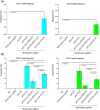High-efficiency retron-mediated single-stranded DNA production in plants
- PMID: 36452068
- PMCID: PMC9700382
- DOI: 10.1093/synbio/ysac025
High-efficiency retron-mediated single-stranded DNA production in plants
Abstract
Retrons are a class of retroelements that produce multicopy single-stranded DNA (ssDNA) and participate in anti-phage defenses in bacteria. Retrons have been harnessed for the overproduction of ssDNA, genome engineering and directed evolution in bacteria, yeast and mammalian cells. Retron-mediated ssDNA production in plants could unlock their potential applications in plant biotechnology. For example, ssDNA can be used as a template for homology-directed repair (HDR) in several organisms. However, current gene editing technologies rely on the physical delivery of synthetic ssDNA, which limits their applications. Here, we demonstrated retron-mediated overproduction of ssDNA in Nicotiana benthamiana. Additionally, we tested different retron architectures for improved ssDNA production and identified a new retron architecture that resulted in greater ssDNA abundance. Furthermore, co-expression of the gene encoding the ssDNA-protecting protein VirE2 from Agrobacterium tumefaciens with the retron systems resulted in a 10.7-fold increase in ssDNA production in vivo. We also demonstrated clustered regularly interspaced short palindromic repeats-retron-coupled ssDNA overproduction and targeted HDR in N. benthamiana. Overall, we present an efficient approach for in vivo ssDNA production in plants, which can be harnessed for biotechnological applications. Graphical Abstract.
Keywords: CRISPR-Cas9; HDR; VirE2; retron; ssDNA.
© The Author(s) 2022. Published by Oxford University Press.
Figures





Similar articles
-
Bacterial Retrons Enable Precise Gene Editing in Human Cells.CRISPR J. 2022 Feb;5(1):31-39. doi: 10.1089/crispr.2021.0065. Epub 2022 Jan 24. CRISPR J. 2022. PMID: 35076284 Free PMC article.
-
Intracellularly synthesized ssDNA for continuous genome engineering.Trends Biotechnol. 2025 Jun;43(6):1356-1370. doi: 10.1016/j.tibtech.2024.10.011. Epub 2024 Nov 12. Trends Biotechnol. 2025. PMID: 39537537 Review.
-
Precise genome editing across kingdoms of life using retron-derived DNA.Nat Chem Biol. 2022 Feb;18(2):199-206. doi: 10.1038/s41589-021-00927-y. Epub 2021 Dec 23. Nat Chem Biol. 2022. PMID: 34949838 Free PMC article.
-
Reducing competition between msd and genomic DNA improves retron editing efficiency.EMBO Rep. 2024 Dec;25(12):5316-5330. doi: 10.1038/s44319-024-00311-6. Epub 2024 Nov 5. EMBO Rep. 2024. PMID: 39501049 Free PMC article.
-
Advance trends in targeting homology-directed repair for accurate gene editing: An inclusive review of small molecules and modified CRISPR-Cas9 systems.Bioimpacts. 2022;12(4):371-391. doi: 10.34172/bi.2022.23871. Epub 2022 Jun 22. Bioimpacts. 2022. PMID: 35975201 Free PMC article. Review.
Cited by
-
High throughput variant libraries and machine learning yield design rules for retron gene editors.Nucleic Acids Res. 2025 Jan 11;53(2):gkae1199. doi: 10.1093/nar/gkae1199. Nucleic Acids Res. 2025. PMID: 39658047 Free PMC article.
-
High Throughput Variant Libraries and Machine Learning Yield Design Rules for Retron Gene Editors.bioRxiv [Preprint]. 2024 Jul 9:2024.07.08.602561. doi: 10.1101/2024.07.08.602561. bioRxiv. 2024. Update in: Nucleic Acids Res. 2025 Jan 11;53(2):gkae1199. doi: 10.1093/nar/gkae1199. PMID: 39026735 Free PMC article. Updated. Preprint.
-
Simultaneous multi-site editing of individual genomes using retron arrays.bioRxiv [Preprint]. 2023 Jul 17:2023.07.17.549397. doi: 10.1101/2023.07.17.549397. bioRxiv. 2023. Update in: Nat Chem Biol. 2024 Nov;20(11):1482-1492. doi: 10.1038/s41589-024-01665-7. PMID: 37503029 Free PMC article. Updated. Preprint.
-
Simultaneous multi-site editing of individual genomes using retron arrays.Nat Chem Biol. 2024 Nov;20(11):1482-1492. doi: 10.1038/s41589-024-01665-7. Epub 2024 Jul 9. Nat Chem Biol. 2024. PMID: 38982310 Free PMC article.
-
Genome-Wide Identification, Evolution and Expression Analysis of GRAS Transcription Factor Gene Family Under Viral Stress in Nicotiana benthamiana.Plants (Basel). 2025 Jul 25;14(15):2295. doi: 10.3390/plants14152295. Plants (Basel). 2025. PMID: 40805644 Free PMC article.
References
-
- Gao C. and Nielsen K.K. (2013) Comparison between Agrobacterium-mediated and direct gene transfer using the gene gun. In: Biolistic DNA Delivery. Springer, pp. 3–16. - PubMed
-
- Vinoth S., Gurusaravanan P. and Jayabalan N. (2013) Optimization of factors influencing microinjection method for Agrobacterium tumefaciens-mediated transformation of tomato. Appl. Biochem. Biotechnol., 169, 1173–1187. - PubMed
LinkOut - more resources
Full Text Sources
Other Literature Sources
